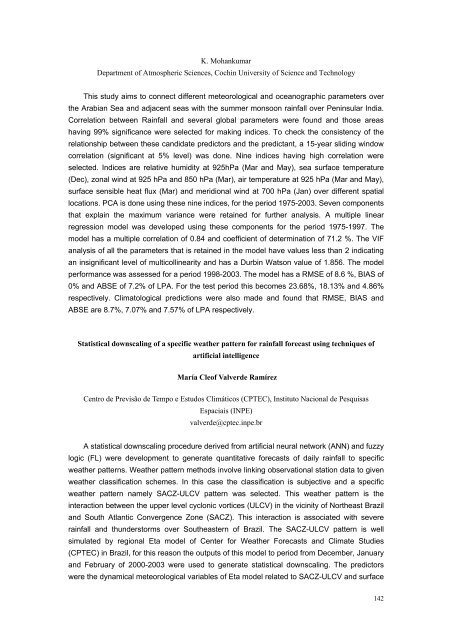The tenth IMSC, Beijing, China, 2007 - International Meetings on ...
The tenth IMSC, Beijing, China, 2007 - International Meetings on ...
The tenth IMSC, Beijing, China, 2007 - International Meetings on ...
You also want an ePaper? Increase the reach of your titles
YUMPU automatically turns print PDFs into web optimized ePapers that Google loves.
K. Mohankumar<br />
Department of Atmospheric Sciences, Cochin University of Science and Technology<br />
This study aims to c<strong>on</strong>nect different meteorological and oceanographic parameters over<br />
the Arabian Sea and adjacent seas with the summer m<strong>on</strong>so<strong>on</strong> rainfall over Peninsular India.<br />
Correlati<strong>on</strong> between Rainfall and several global parameters were found and those areas<br />
having 99% significance were selected for making indices. To check the c<strong>on</strong>sistency of the<br />
relati<strong>on</strong>ship between these candidate predictors and the predictant, a 15-year sliding window<br />
correlati<strong>on</strong> (significant at 5% level) was d<strong>on</strong>e. Nine indices having high correlati<strong>on</strong> were<br />
selected. Indices are relative humidity at 925hPa (Mar and May), sea surface temperature<br />
(Dec), z<strong>on</strong>al wind at 925 hPa and 850 hPa (Mar), air temperature at 925 hPa (Mar and May),<br />
surface sensible heat flux (Mar) and meridi<strong>on</strong>al wind at 700 hPa (Jan) over different spatial<br />
locati<strong>on</strong>s. PCA is d<strong>on</strong>e using these nine indices, for the period 1975-2003. Seven comp<strong>on</strong>ents<br />
that explain the maximum variance were retained for further analysis. A multiple linear<br />
regressi<strong>on</strong> model was developed using these comp<strong>on</strong>ents for the period 1975-1997. <str<strong>on</strong>g>The</str<strong>on</strong>g><br />
model has a multiple correlati<strong>on</strong> of 0.84 and coefficient of determinati<strong>on</strong> of 71.2 %. <str<strong>on</strong>g>The</str<strong>on</strong>g> VIF<br />
analysis of all the parameters that is retained in the model have values less than 2 indicating<br />
an insignificant level of multicollinearity and has a Durbin Wats<strong>on</strong> value of 1.856. <str<strong>on</strong>g>The</str<strong>on</strong>g> model<br />
performance was assessed for a period 1998-2003. <str<strong>on</strong>g>The</str<strong>on</strong>g> model has a RMSE of 8.6 %, BIAS of<br />
0% and ABSE of 7.2% of LPA. For the test period this becomes 23.68%, 18.13% and 4.86%<br />
respectively. Climatological predicti<strong>on</strong>s were also made and found that RMSE, BIAS and<br />
ABSE are 8.7%, 7.07% and 7.57% of LPA respectively.<br />
Statistical downscaling of a specific weather pattern for rainfall forecast using techniques of<br />
artificial intelligence<br />
María Cleof Valverde Ramírez<br />
Centro de Previsão de Tempo e Estudos Climáticos (CPTEC), Instituto Naci<strong>on</strong>al de Pesquisas<br />
Espaciais (INPE)<br />
valverde@cptec.inpe.br<br />
A statistical downscaling procedure derived from artificial neural network (ANN) and fuzzy<br />
logic (FL) were development to generate quantitative forecasts of daily rainfall to specific<br />
weather patterns. Weather pattern methods involve linking observati<strong>on</strong>al stati<strong>on</strong> data to given<br />
weather classificati<strong>on</strong> schemes. In this case the classificati<strong>on</strong> is subjective and a specific<br />
weather pattern namely SACZ-ULCV pattern was selected. This weather pattern is the<br />
interacti<strong>on</strong> between the upper level cycl<strong>on</strong>ic vortices (ULCV) in the vicinity of Northeast Brazil<br />
and South Atlantic C<strong>on</strong>vergence Z<strong>on</strong>e (SACZ). This interacti<strong>on</strong> is associated with severe<br />
rainfall and thunderstorms over Southeastern of Brazil. <str<strong>on</strong>g>The</str<strong>on</strong>g> SACZ-ULCV pattern is well<br />
simulated by regi<strong>on</strong>al Eta model of Center for Weather Forecasts and Climate Studies<br />
(CPTEC) in Brazil, for this reas<strong>on</strong> the outputs of this model to period from December, January<br />
and February of 2000-2003 were used to generate statistical downscaling. <str<strong>on</strong>g>The</str<strong>on</strong>g> predictors<br />
were the dynamical meteorological variables of Eta model related to SACZ-ULCV and surface<br />
142






![final_program_abstracts[1]](https://img.yumpu.com/19102520/1/174x260/final-program-abstracts1.jpg?quality=85)









